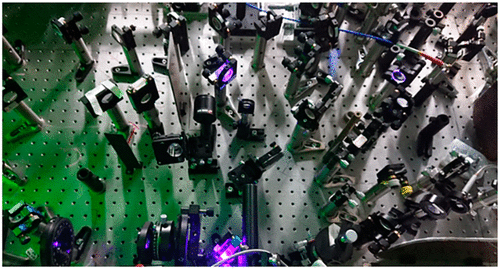当前位置:
X-MOL 学术
›
Anal. Chem.
›
论文详情
Our official English website, www.x-mol.net, welcomes your
feedback! (Note: you will need to create a separate account there.)
Generation of a Nearly Monocycle Optical Pulse in the Near-Infrared Region and Its Use as an Ionization Source in Mass Spectrometry.
Analytical Chemistry ( IF 6.7 ) Pub Date : 2020-04-10 , DOI: 10.1021/acs.analchem.0c00542 Yuta Nakano 1 , Tomoko Imasaka 2 , Totaro Imasaka 3, 4
Analytical Chemistry ( IF 6.7 ) Pub Date : 2020-04-10 , DOI: 10.1021/acs.analchem.0c00542 Yuta Nakano 1 , Tomoko Imasaka 2 , Totaro Imasaka 3, 4
Affiliation

|
We report on the generation of an octave-spanning (600-1400 nm) nearly monocycle (1.1 cycle) ultrashort optical pulse (3.2 fs) in the near-infrared region by the Fourier synthesis of two pulses at 800 and 1200 nm, both of which were spectrally broadened by self-phase modulation and were compressed by chirp mirrors. The 3.2 fs pulse was converted into the ultraviolet by third harmonic generation, the pulse width being evaluated to 1.9 fs. The near-infrared pulse (3.2 fs) was employed as an ionization source in mass spectrometry, and the signal intensity was significantly increased for pentachlorobenzene, an environmental pollutant listed in the Stockholm Convention. The present data and the spectral properties obtained by quantum chemical calculations suggest that the method offers a potential advantage for the detection of Novichok, a chemical warfare agent that is thought to have been used in a terrorist attack.
中文翻译:

在近红外区域中产生近单周期光脉冲,并将其用作质谱中的电离源。
我们报告了通过在800和1200 nm处的两个脉冲的傅立叶合成在近红外区域产生一个跨度为八度(600-1400 nm)的近单周期(1.1周期)的超短光脉冲(3.2 fs)。通过自相位调制在光谱上加宽并通过and镜压缩。通过产生三次谐波将3.2 fs的脉冲转换为紫外线,并将脉冲宽度评估为1.9 fs。在质谱法中,将近红外脉冲(3.2 fs)用作电离源,五氯苯是《斯德哥尔摩公约》所列的环境污染物,信号强度显着提高。现有数据和通过量子化学计算获得的光谱性质表明,该方法为检测Novichok,
更新日期:2020-04-01
中文翻译:

在近红外区域中产生近单周期光脉冲,并将其用作质谱中的电离源。
我们报告了通过在800和1200 nm处的两个脉冲的傅立叶合成在近红外区域产生一个跨度为八度(600-1400 nm)的近单周期(1.1周期)的超短光脉冲(3.2 fs)。通过自相位调制在光谱上加宽并通过and镜压缩。通过产生三次谐波将3.2 fs的脉冲转换为紫外线,并将脉冲宽度评估为1.9 fs。在质谱法中,将近红外脉冲(3.2 fs)用作电离源,五氯苯是《斯德哥尔摩公约》所列的环境污染物,信号强度显着提高。现有数据和通过量子化学计算获得的光谱性质表明,该方法为检测Novichok,


















































 京公网安备 11010802027423号
京公网安备 11010802027423号